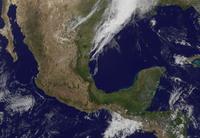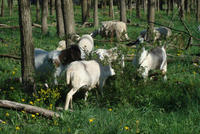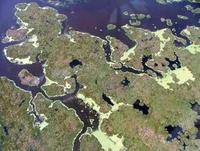-
Colorado tries to increase safety of urban development in wildfire-prone areas
Colorado continues to deal with the challenge of building new urban developments while reducing wildfire risks. There are currently 556,000 houses built in burn zones around the state, and the demand for water to sustain residents and industries continue to rise. A new study predicts that development will occupy 2.1 million acres in wildfire-prone forests by 2030, an increase from one million acres today — just as wildfires continue to burn roughly 900,000 acres a year since 2000, compared with just 200,000 acres a year in the 1990s.
-
-
Limiting methane emissions would more quickly affect climate than limiting CO2
When discussing climate change, scientists point to “radiative forcing,” a measure of trapped heat in Earth’s atmosphere from man-made greenhouse gases. The current role of methane looms large, they say, contributing over 40 percent of current radiative forcing from all greenhouse gases. The role of methane as a driver of global warming is even more critical than this 40 percent value might indicate, they note, since the climate system responds much more quickly to reducing methane than to reducing carbon dioxide. The implication is that while it is true that in order to slow, or even reverse, global warming we must limit emissions of both carbon dioxide and methane, it makes more sense to concentrate now on limiting methane emissions because reducing methane emissions would buy society some critical decades of lower temperatures.
-
-
Coral reefs offer valuable protection for coastal infrastructure
Growing natural hazards from coastal storms, flooding, and rising sea levels are leading to major investments worldwide in coastal defense structures such as seawalls and breakwaters. A new study shows that coral reefs can provide risk reduction benefits comparable to artificial defenses, and reef restoration and enhancement is a cost-effective alternative to manmade structures. Restoring coral reefs as a way to protect coastal infrastructure is also cheaper: the typical price for a tropical breakwater project is $197 million, compared with $129 million for restoring a reef.
-
-
Loss of West Antarctic glacier unstoppable, contributing significantly to sea level rise
A rapidly melting section of the West Antarctic Ice Sheet appears to be in irreversible decline, with nothing to stop the entire glacial basin from disappearing into the sea, according to researchers at UC Irvine and NASA. The new study presents multiple lines of evidence — incorporating forty years of observations — that six massive glaciers in the Amundsen Sea sector “have passed the point of no return.” The volume of melted ice would be enough to raise global sea level by four feet.
-
-
Large areas of Plains states now drier than during Dust Bowl

As a result of the drought conditions that have largely remained a constant since 2011, parts of the Texas and Oklahoma panhandles, as well as northeastern New Mexico and southeaster Colorado, are now drier than they were during the infamous Dust Bowl of the 1930s. While experts explain that the possibility of another Dust Bowl is not likely due to modern farming and irrigation techniques which have been enacted as a response in the 1930s, greater erosion due to drought and wind has resulted in a number of vicious dust storms.
-
-
Farmers try to cope with the challenges posed by extreme weather
Across the country, farmers are reporting that they are at yet another critical juncture for agriculture. Citing more unpredictable and severe weather due to climate change, scientists are researching defensive measures and looking to previous agricultural challenges for inspiration. Some are looking to the way individual farmers and government agencies addressed the Dust Bowl hardships of America during the Great Depression as a source of inspiration.
-
-
Miami “Ground Zero” for risks associated with sea level rise
During a special Senate hearing last month in Miami Beach, Senator Bill Nelson (D-Florida) described Florida as “Ground Zero” for climate change and the threat it poses to coastal communities. Sea level rise is especially worrisome to Floridians because Miami has the most property assets at risk in the world, according to the World Resources Institute(WRI). Miami has $14.7 billion in beach front property. Also, fifteen million out of the state’s twenty million residents live in coastal communities vulnerable to sea level rise.
-
-
Researchers map 198,000 glaciers to improve sea-level rise estimates
An international team of researchers has completed the first mapping of virtually all of the world’s glaciers — including their locations and sizes — allowing for calculations of their volumes and ongoing contributions to global sea rise as the world warms. The team mapped and catalogued some 198,000 glaciers around the world as part of the massive Randolph Glacier Inventory, or RGI, better to understand rising seas over the coming decades as a result of melting glaciers.
-
-
As fracking activity grows in Mexico, so does the number of fracking-induced tremors

Mexico has the fourth largest amount of recoverable shale gas in the world, with 681 trillion cubic feet. As fracking activity has increased in the state of Nuevo Leon, so have the number of tremors. Between January and mid-April, forty-eight tremors, some reaching a magnitude of roughly 4.3, were recorded across the state of Nuevo Leon, compared to two tremors in the same period last year.
-
-
Ice melting in East Antarctica may lead to unstoppable sea-level rise

The melting of a rather small ice volume on East Antarctica’s shore could trigger a persistent ice discharge into the ocean, resulting in unstoppable sea-level rise for thousands of years to come, a new study finds. East Antarctica’s Wilkes Basin is like a bottle on a slant, say the study’s authors. Once uncorked, it empties out. The basin is the largest region of marine ice on rocky ground in East Antarctica.
-
-
Energy-subsidy reform can reduce carbon emissions, add years to oil exports: study
Reform of energy subsidies in oil-exporting countries can reduce carbon emissions and add years to oil exports, according to a new study. The study reviews the record of energy-subsidy reforms and argues that big exporters should reduce energy demand by raising prices, and that this can be done without undermining legitimacy of governments that depend on subsidies for political support
-
-
Switching from cattle fields to “carbon farms” to tackle climate change

Changing cattle fields to forests is a cheap way of tackling climate change and saving species threatened with extinction, a new study has found. The main use of land in communities the western Andes of Colombia is cattle farming, but a new study found farmers could make the same or more money by allowing their land naturally to regenerate. Researchers report that under carbon markets designed to stop global warming, these farmers could get paid to change the use of their land from growing cows to “growing carbon” — receiving around $1.99 per ton of carbon dioxide the trees remove from the atmosphere.
-
-
Wetland preservation is good business

A recently published study is making the case for wetland preservation by highlighting the economic incentives that such preservation could provide to urban centers.Infrastructure investment in urban waterfronts could soon be seen as one of the best economic decisions a city could make. The National Oceanic and Atmospheric Administration says that “$1 million invested in coastal restoration creates 17.1 jobs, compared to just 8.9 jobs for every $1 million invested in oil and gas development.”
-
-
U.S. corn yields increasingly vulnerable to hot, dry weather
The United States produces 40 percent of the world’s corn, mostly in Iowa, Illinois, and Indiana. As more than 80 percent of U.S. agricultural land relies on natural rainfall rather than irrigation, corn farmers in these regions depend on precipitation, air temperature, and humidity for optimal plant growth. U.S. corn yields are growing more sensitive to heat and drought. Farmers are faced with difficult tradeoffs in adapting to a changing climate in which unfavorable weather will become more common.
-
-
Longer periods of tornado activity are more destructive, but also more predictable
Significant tornado outbreaks, and especially strong tornadoes, are more likely occur within periods of activity lasting three or more days, according to a new study. The study examined thirty years of U.S. weather records and found that an outbreak of twenty or more reported tornadoes had a 74 percent probability of occurring during a period of tornado activity lasting three or more days. During those same periods, a tornado rated 3 or higher on the Enhanced Fujita scale had a 60 percent probability of hitting.
-
- All
- Regional
- Water
- Biometrics
- Borders/Immig
- Business
- Cybersecurity
- Detection
- Disasters
- Government
- Infrastructure
- International
- Public health
- Public Safety
- Communication interoperabillity
- Emergency services
- Emergency medical services
- Fire
- First response
- IEDs
- Law Enforcement
- Law Enforcement Technology
- Military technology
- Nonlethal weapons
- Nuclear weapons
- Personal protection equipment
- Police
- Notification /alert systems
- Situational awareness
- Weapons systems
- Sci-Tech
- Sector Reports
- Surveillance
- Transportation
Advertising & Marketing: advertise@newswirepubs.com
Editorial: editor@newswirepubs.com
General: info@newswirepubs.com
2010-2011 © News Wire Publications, LLC News Wire Publications, LLC
220 Old Country Road | Suite 200 | Mineola | New York | 11501
Permissions and Policies
Editorial: editor@newswirepubs.com
General: info@newswirepubs.com
2010-2011 © News Wire Publications, LLC News Wire Publications, LLC
220 Old Country Road | Suite 200 | Mineola | New York | 11501
Permissions and Policies
